Past, present, future: a new CEDIT collection employs a host of Italian design talent
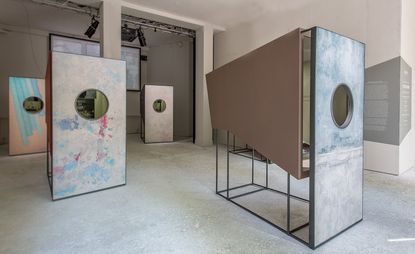
Earlier this year, Italian ceramic tiles authority Florim relaunched historic brand CEDIT – Ceramiche d’Italia, unveiling a collection that marks a new chapter in the company’s history.
For the occasion, a group of Italian designers has explored CEDIT’s ceramic capabilities with a plethora of creative solutions for flat surfaces, that range from embossed concrete to iridescent treatments. Each new collection was shown on a diorama-like structure at the Spazio CEDIT in Milan. The first six studios to experiment with the surfaces were BRH+ (Barbara Brondi and Marco Rainò), Marco Casamonti of Archea Associati, Giorgio Griffa, Franco Guerzoni, Matteo Nunziati and Wallpaper* Handmade contributors Giorgia Zanellato and Daniele Bortotto, who offered new points of view on ceramic tiles, testing out materials and treatments.
The new collections include iridescent and metallic tiles by Casamonti, who intervened on the passivation processes of the metal to create moody surfaces. The series created by BRH+ explores the textures of cement, with different iterations arranged in modular compositions using bright shades for the grouting. Abstract painter Griffa applied his signature brush strokes to the surfaces, using the slabs as large canvases to create a series of paintings. Guerzoni, another contemporary artist, worked on the surface’s texture and pigmentation, creating a covering defined by a poetic crumbling effect. Architect Nunziati offered a more practical surface solution inspired by layers of exotic fabrics and decorations, while Zanellato and Bortotto referenced worn plastered walls in their design.
The brand relaunch and these collections present the diverse possibilities of CEDIT and are testament to its open stance on design, but the company’s present and its future are directly informed by its illustrious past. Founded in the 1950s, it was given a no-nonsense name (an acronym which stands for ‘Ceramics of Italy’) and offered an innovative and radical approach to surfaces. From the 1950s until the 1990s, the company collaborated with some of the most illustrious design names of the era. Alessandro Mendini, Ettore Sottsass and Bob Noorda, among others, were part of the ever-growing tile designs portfolio, and CEDIT also enlisted Marco Zanuso to create installations for the Milan shop as well as tiles for the company. These largely forgotten collections remain a hidden, treasured heritage for CEDIT, as it continues to combine research and innovation with contemporary art and design.

The new collection was shown on a diorama-like structure at the Spazio CEDIT in Milan. Pictured: the surface treatment created by Wallpaper* Handmade contributors Giorgia Zanellato and Daniele Bortotto, who referenced worn plastered walls in their design

Contemporary artist Franco Guerzoni worked on the surface’s texture and pigmentation, creating a covering defined by a poetic crumbling effect
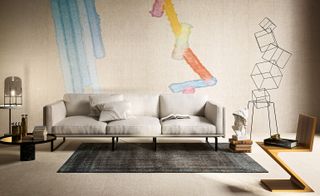
Abstract painter Giorgio Griffa applied his signature brush strokes to the surfaces, using the slabs as large canvases to create a series of paintings
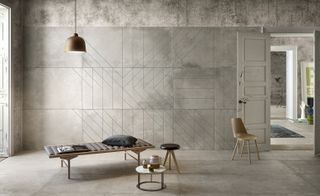
The series created by BRH+ explores the textures of cement, with different iterations arranged in modular compositions and using bright shades for the grouting

The new collections include iridescent and metallic tiles by Marco Casamonti, who intervened on the passivation processes of the metal to create moody surfaces
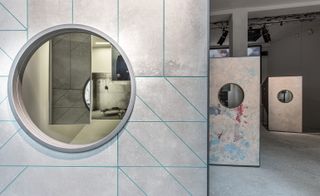
A view of the installation in Milan, with tiles by BRH+ on the foreground and work by Franco Guerzoni on the background
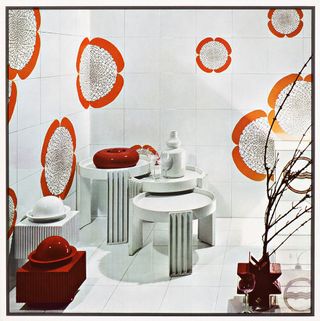
From the 1950s until the 1990s, the company collaborated with some of the most illustrious design names of the era: Alessandro Mendini, Ettore Sottsass and Bob Noorda, among others, were part of the ever-growing tile designs portfolio. Pictured: a floral tile design by Marco Zanuso, from 1971
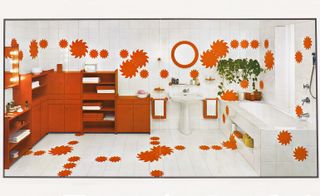
A tile design by Marco Zanuso, from the Cedit archives. As well as designing tiles for the company, Zanuso also created installations for its Milan shop in the 1950s

The brand relaunch and these collections present the diverse possibilities of CEDIT and are testament to its open stance on design, but the company’s present and its future are directly informed by its illustrious design past. Italian architect Sergio Asti was among the collaborators for the brand, creating this organic design in the 1970s

Bob Noorda's tile design for Cedit, from the company's 1971 catalogue
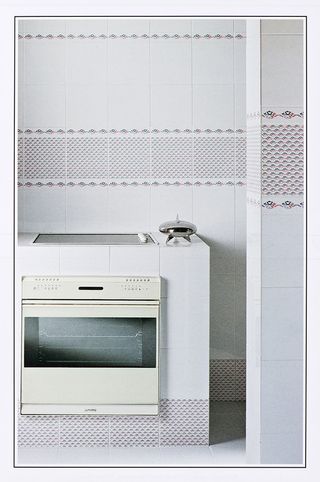
A reduced motif by Alessandro Mendini was part of Cedit's 1993 catalogue

Marcello Pirro's creation was part of Cedit's 1973 'Serie Pittori' ('Painters' Series')
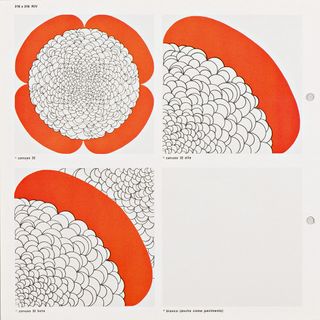
Also part of the 'Serie Pittori' was this design by Marco Zanuso
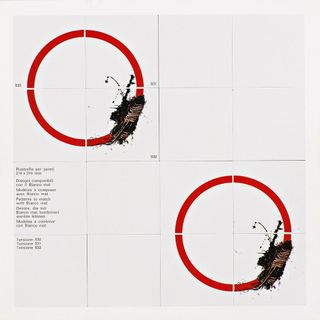
Painter Emilio Scanavino's design for the 'Serie Pittori'

These largely forgotten collections, featuring Ettore Sottsass' black and yellow creation, remain a hidden, treasured heritage for Cedit, as it continues to combine research and innovation with contemporary art and design
INFORMATION
For more information, visit CEDIT’s website
Wallpaper* Newsletter
Receive our daily digest of inspiration, escapism and design stories from around the world direct to your inbox
Rosa Bertoli was born in Udine, Italy, and now lives in London. Since 2014, she has been the Design Editor of Wallpaper*, where she oversees design content for the print and online editions, as well as special editorial projects. Through her role at Wallpaper*, she has written extensively about all areas of design. Rosa has been speaker and moderator for various design talks and conferences including London Craft Week, Maison & Objet, The Italian Cultural Institute (London), Clippings, Zaha Hadid Design, Kartell and Frieze Art Fair. Rosa has been on judging panels for the Chart Architecture Award, the Dutch Design Awards and the DesignGuild Marks. She has written for numerous English and Italian language publications, and worked as a content and communication consultant for fashion and design brands.
-
 Pininfarina Battista Reversario is a new one-off electric hypercar
Pininfarina Battista Reversario is a new one-off electric hypercarThe all-electric Pininfarina Battista Reversario is joining its aesthetic inverse in an ultra-select car collector’s garage. We take a look at a car built to a very precise order
By Jonathan Bell Published
-
 Fernando Jorge’s fluid diamond earrings show his curve appeal
Fernando Jorge’s fluid diamond earrings show his curve appealDiscover Brazilian jewellery designer Fernando Jorge's snake-like silhouettes and graphic shapes
By Hannah Silver Published
-
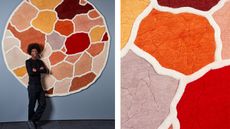 Abreham Brioschi debuts Ethiopia-inspired rugs for Nodus
Abreham Brioschi debuts Ethiopia-inspired rugs for NodusAbreham Brioschi teams up with luxury rug experts Nodus to translate visions from his heritage into a tactile reality
By Ifeoluwa Adedeji Published
-
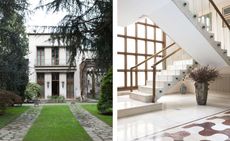 Alcova announces two historical locations for its 2024 edition
Alcova announces two historical locations for its 2024 editionPrepare to discover two iconic gems, as Alcova 2024 will take place at Villa Borsani and Villa Bagatti Valsecchi, just outside Milan (15 – 21 April 2024)
By Rosa Bertoli Published
-
 Lake Como Design Festival 2023, across historic venues, shows the diverse roles design plays in shaping our world
Lake Como Design Festival 2023, across historic venues, shows the diverse roles design plays in shaping our worldLake Como Design Festival 2023 (until 24 September 2023) features a series of exhibitions inspired by Pliny the Elder's Natural History
By Maria Cristina Didero Published
-
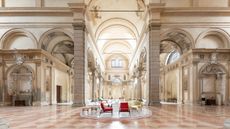 Inside Volumnia gallery: design in a Renaissance church
Inside Volumnia gallery: design in a Renaissance churchPiacenza’s Volumnia Gallery is the brainchild of art dealer Enrica De Micheli, who created an art and design hub and restaurant in a Renaissance basilica
By Maria Cristina Didero Published
-
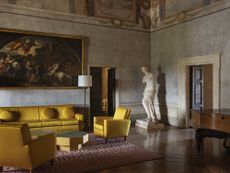 India Mahdavi animates Villa Medici with a colourful and contemporary restyling
India Mahdavi animates Villa Medici with a colourful and contemporary restylingAt Rome’s Villa Medici, India Mahdavi's intervention is the latest in a series of ‘re-enchantments’ of the 16th-century architecture and interiors
By Laura May Todd Published
-
 Giorgetti Spiga – The Place opens in Milan’s fashion quarter
Giorgetti Spiga – The Place opens in Milan’s fashion quarterThe new Giorgetti Spiga – The Place transforms a 17th-century palazzo in Milan, showcasing the furniture company's full offering over four floors
By Maria Cristina Didero Published
-
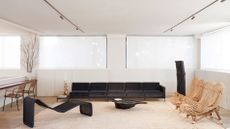 Brianza’s Bonacina Museum explores the history of Italian rattan furniture
Brianza’s Bonacina Museum explores the history of Italian rattan furnitureWe visit Bonacina's Museo Galleria Giardino, showcasing the company's 134-year history with rattan furniture from its HQ in Brianza
By Emma O'Kelly Published
-
 Giuseppe Arezzi’s multifunctional designs combine a modern approach with his Sicilian roots
Giuseppe Arezzi’s multifunctional designs combine a modern approach with his Sicilian rootsFrom his native Sicily, designer Giuseppe Arezzi creates well-considered projects defined by his lively, subtle and witty approach to design
By Maria Cristina Didero Published
-
 Objects of Common Interest lights up rationalist Bergamo square
Objects of Common Interest lights up rationalist Bergamo square‘Lights On’ is a new site-specific installation by Objects of Common Interest in Bergamo, part of the city’s Italian Capital of Culture 2023 programme
By Rosa Bertoli Published